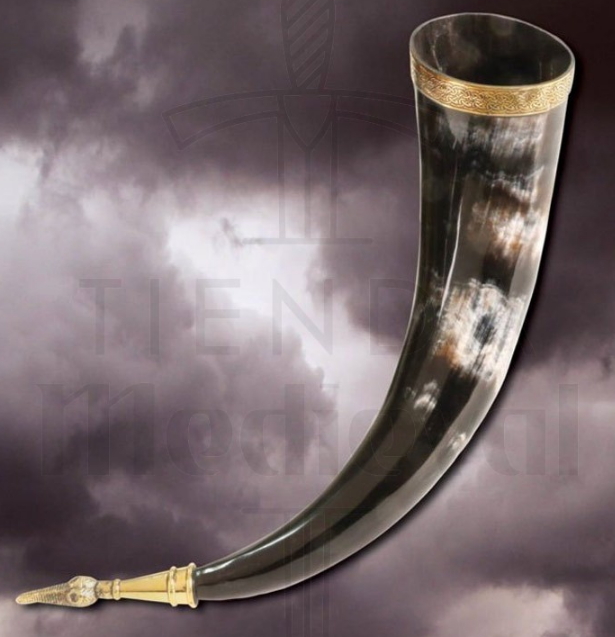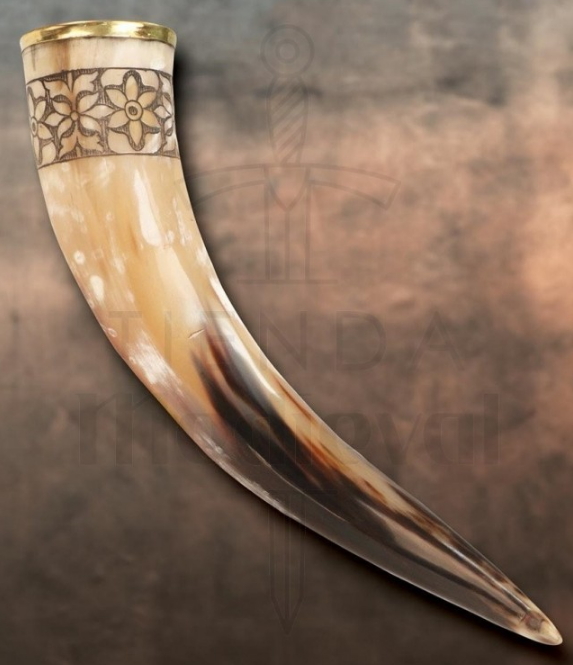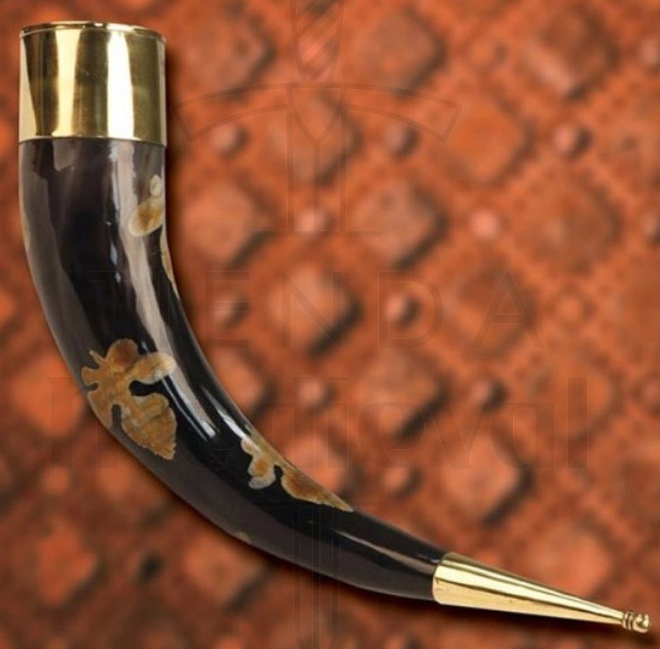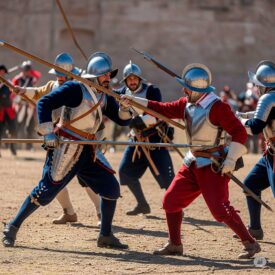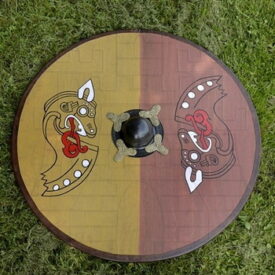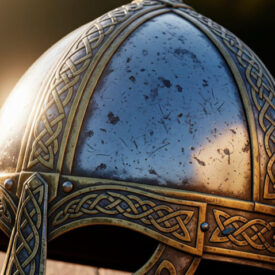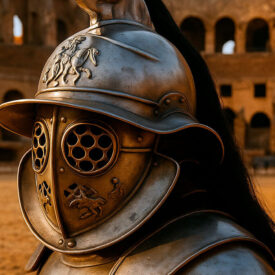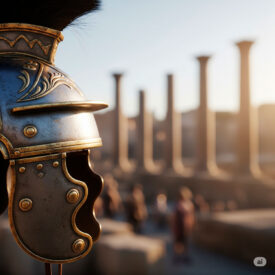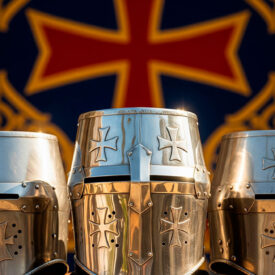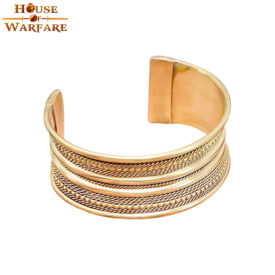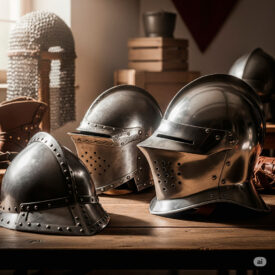Greetings, time travelers and history lovers! Have you ever imagined a fierce Viking warrior with an imposing horned helmet, raising a horn to drink mead as he prepares for battle? If so, you’re not alone. This image is deeply rooted in popular culture. But how much truth is there to it? Get ready to debunk a myth and dive into the fascinating reality of Viking horns and their use, dispelling the fantasy of horned Viking helmets and revealing their true style.
—
The Great Myth: Horned Helmets? Pure Fiction!
Let’s start with the big reveal: the idea that Vikings wore horned helmets is, in fact, a widespread myth. Although the image of the “fearsome Viking with a horned helmet” is recurrent in operas, modern movies, and comics, the truth is that it doesn’t match historical reality. Ox horns on a helmet were unthinkable for combat.
Where Does This Myth Come From?
The myth of horned helmets has its roots in the 19th century. During this period, artists and costume designers began to romanticize the Viking era, adding horns to make the warriors appear more “wild and untamed.” Operas, especially the famous works of Richard Wagner like “The Ring of the Nibelung,” had a huge influence, depicting Vikings and Norse gods with these dramatic helmets. Hollywood and comics, such as “Hägar the Horrible,” continued to perpetuate this image, deeply embedding it in modern Western imagination. Thus, the fantasy of the Viking drinking horn merged with the image of the helmet, creating confusion that persists to this day despite historical evidence.
Archaeological Evidence Speaks for Itself
Archaeological findings are clear: Viking helmets did not have horns. They were simple and functional, made mainly of iron, often with a nasal guard for face protection. Authentic Viking equipment prioritized practicality and survival in battle.
- The Gjermundbu Helmet: Found in Norway and dated to the 10th century, it is the only fully preserved Viking helmet. It has a rounded dome and a nasal guard, showing that Vikings preferred effective helmets for combat, typical of the High Middle Ages. There is no trace of horns, debunking the idea of a medieval drinking horn integrated into the helm.
- Viksø Helmets: Although these horned helmets were found in Denmark, they date back to the Bronze Age (around 900 BC), more than 1,000 years before the Viking Age! They were probably ceremonial and not used in battle. Their style was purely ritualistic.
- Tapestries and Armor: The Oseberg Tapestry shows figures with horned headdresses, but historians believe these were ceremonial or religious representations, not battle helmets. Other findings, such as chainmail, shields, and swords, highlight the importance of practicality and protection in Viking gear. The idea of a Viking drinking with a horned helmet is, therefore, completely unfounded.
Horns on a helmet would have been impractical and dangerous in combat, easy for the enemy to grab. They would have added weight and been unstable, especially in the confined spaces of Viking ships. Historical accuracy helps us appreciate the true Viking culture, which valued functionality in their war gear, not an ox horn integrated into their protection. Viking war products were robust and efficient, without decorations that would endanger the warrior’s life.
—
The True History of Viking Horns: A Symbol of Culture and Camaraderie
Although they didn’t wear them on their helmets, Vikings did use horns in other important ways. The Viking horn, whether for calling or for drinking beer and other beverages, is a symbol deeply rooted in Viking history and culture. These ox horns were mostly practical vessels or communication tools, far from cinematic fantasy.
Origins and Evolution of Horns
Viking horns were made from ox horns, and the oldest finds date back to the 8th century. Over time, these products evolved and became more artistic, with craftsmen carving intricate patterns and designs. Each horn cup was a unique piece, often with a natural finish, reflecting the artisan’s skill and the style of the era.
Practical Uses in Viking Daily Life
Horns played a significant role in the daily life of Vikings. They were not only vessels for drinking beer or mead, but also had multiple essential functions. Each horn cup and mug was a multifunctional object.
- Calling/Signal Horns: They were used as signaling devices to transmit messages over long distances, in military operations, sea voyages, or during hunting. Their loud and penetrating sound was ideal for coordinating attacks and communicating orders. Celts and Romans also used horns for signaling and as psychological warfare. The medieval horn was a vital communication tool.
- Domestic Vessels: They also served as containers for liquids such as milk or water, and even for transporting grains and other foods. Their versatility made them an indispensable part of daily life. Vikings also used wooden, ceramic, and glass bowls for drinking. A drinking horn could be as common as a wooden cup, but with superior style and durability.
The Central Role in Feasts and Ceremonies
One of the most well-known uses of Viking horns was as drinking horns at feasts and ceremonies. These vessels were not mere tools, but “emblems of status, skill, and community bonds.” Beer and mead flowed abundantly at these events, served in large cups and horn mugs.
- Social and Ritual: They were passed among guests as a gesture of unity and camaraderie, strengthening social bonds. They were often filled with mead, the traditional Viking drink, and used in ritual libations where stories were told, songs were sung, and the gods were honored. Sharing a drinking horn was a gesture of hospitality and mutual respect, a ritual deeply rooted in the culture.
- Oaths and Feats: These horns had great ceremonial weight, used in oaths and toasts that bound individuals to their word under the supervision of the gods. Feats accomplished under the influence of alcohol could seal one’s fate. A horn cup was not just a vessel, but a witness to promises and achievements.
- Status Symbol: The quality and decoration of the horn often reflected the user’s status and wealth. Chiefs and warriors had more ornate versions, with exceptional polishing or elaborate engravings. Owning a beautifully crafted ox horn was a sign of distinction.
- Divine Inspiration: Certain alcoholic beverages were believed to have supernatural properties, such as the “Mead of Poetry” from Norse mythology, which was associated with Odin’s wisdom and poetic inspiration. A medieval drinking horn thus became a bridge to the divine.
Key Archaeological Finds of Drinking Horns
Archaeological finds of Viking horns have provided valuable insights into their culture and way of life. These products give us a direct view of Viking life and the importance of these vessels.
- Oseberg Ship: Discovered in 1904 in Norway, it contained several richly decorated drinking horns, indicating high craftsmanship and ceremonial use among the Viking elite. Some even suggest that large cups were used for the most important celebrations.
- Gokstad Ship: Also in Norway, horns were found used in both everyday and ritual contexts. This shows that ox horns were both utilitarian and symbolic.
- Gallehus Golden Horn: Discovered in Denmark in the 17th century, it is a gold drinking horn richly decorated with Norse mythological scenes, showing great artistic skill and the value given to this collection of objects.
Craftsmanship and Making of Viking Horns
The creation of a Viking horn was a meticulous process that fused functionality with art. Vikings mainly used ox horns. The result was a durable and aesthetically pleasing horn cup.
Manufacturing Process:
- Preparation: The horns were carefully selected and processed. First, they were thoroughly cleaned, removing any remaining internal tissue. The initial polishing was crucial for hygiene.
- Molding: Then, they were heated to make them malleable, allowing craftsmen to shape them as desired and remove irregularities. This process ensured that each horn mug had the right shape for drinking.
- Decoration: After shaping, the horns were often decorated with engravings and inlays. These decorations ranged from simple linear patterns to complex representations of animals and mythological scenes. The engravings were made with simple tools like knives and chisels. Some horns were adorned with metal fittings and precious stones, indicating the high status of their owners. The carved Viking horn was a work of art.
The combination of high-quality materials and masterful craftsmanship makes Viking horns fascinating testimonies of a past culture, objects authentically connected to lifestyle and exceptional artisanal skill.
—
Viking Horns Today: Models and Lasting Legacy
The fascination with Viking horns persists today. They are used in Viking festivals, historical reenactments, and themed events. Many modern artisans make them using traditional techniques, making them both functional and decorative. They are highly sought-after products for their unique style and connection to history. Viking cups are an ideal gift for any lover of Nordic culture.
Common Models and Capacities Today
Modern drinking horns vary in size, color, and decoration; being a natural product, each horn is unique. It is recommended to hand wash them before use. There is a large collection of horn cups and mugs available, with various sizes to suit all needs.
- Olga’s Viking Horn: Decorated with a rustic leaf design, with brass rim and tip. It is a horn cup of great beauty and impeccable polish.
- Freya’s Viking Horn: Hand-carved with an intricate floral design and a brass rim, designed for Viking royalty. A carved Viking horn that evokes the nobility of the era.
- Ragnar’s Viking Horn: Intricately hand-carved with a line design. Ideal for drinking beer in style.
- Olaf’s Viking Horn: Hand-painted with a peacock feather, in honor of Olaf the Peacock, an Icelandic chieftain. A cup with a unique and distinctive design.
- Horns with Norse Symbols: Many modern models feature engravings from Norse mythology, making each drinking horn a meaningful piece:
- Valknut: With runes of the Valknut symbol, a knot of the slain.
- Yggdrasil: With the engraving of the World Ash or Tree of Life.
- Fenrir: With the image of the Norse Wolf.
- Mjölnir: Thor’s hammer.
- Dragon: With a dragon engraving.
- Vegvísir: The Viking compass.
- Raven: With raven engravings.
- Capacities: Available in various capacities, from 150 ml up to 0.9 liters, with or without a horn stand. Some are truly large cups, while others are more modest, suitable for serving any beer.
- Stands: Forged iron or steel stands are offered to display the horns, and leather cases to carry them on the belt. An iron or wrought iron stand is the perfect complement for these ox horns, allowing them to be displayed as true collector’s items.
Symbolism and Lasting Legacy: Echoes of a Bygone Era
Viking horns, both historical and replicas, remain much more than simple artifacts. They are “powerful symbols of Nordic culture, craftsmanship, and tradition.” Each Viking drinking horn is a testament to a bygone era, an object authentically connected to history.
- Odin’s Triple Horn: This is a Norse symbol representing the three horns (Óđrœrir, Bođn, and Són) in which the Mead of Poetry was kept, made from the blood of the god Kvasir and honey. This mead granted wisdom and poetic inspiration to Odin, who drank it all. The symbol, which is similar to the triquetra due to its triple symmetry, appears on the Viking runestone of Snoldelev, dated to the 9th century in Denmark. This symbol, often engraved on carved Viking horns, is a reminder of the era’s deep spirituality.
- Viking Values: The association of the drinking horn with masculinity, endurance, and strength was emblematic of Viking society’s values. Viking cups were not only for drinking beer, but for celebrating life, strength, and community.
In summary, Viking horns encapsulate the rich culture and craftsmanship of the Norse, with a deep symbolic meaning that endures to this day. Their varied uses, their role in rituals, and their representation in art and literature make them a fascinating topic. If you’re looking for a mug or cup that combines history and style, ox horns are an exceptional choice.
We hope this deep dive into the world of Viking horns has surprised and captivated you as much as it did us. The truth behind the myth is often richer and more complex. Discovering the true function of an ox horn, whether as a cup, mug, or means of communication, connects us to a fascinating civilization.
At Medieval Shop, we present you with an impressive collection of products that will transport you straight to the Viking era. If you’re looking for an authentic horn cup to drink beer or mead, we have a wide range of ox horns available in various sizes, each with a natural and polished finish. From a large cup perfect for a feast to smaller glasses for everyday use, our collection is unmatched. Each horn mug, each Viking cup, is designed to offer you a genuine experience.
We invite you to explore our selection, which includes: medieval drinking horn, Viking ox horn, Viking drinking horn, wrought iron stand to display your treasure, and carved Viking horn with intricate designs. Enjoy beer or any drink with the style and tradition of the ancestors. Get your own drinking horn and feel the power of history in your hands!
This beautiful Olga Viking horn is a horn cup with a gorgeous rustic leaf decoration. A drinking horn with a brass rim and tip, perfect for enjoying your beer in style. An authentically Viking product, ideal for your collection.
Freya’s Viking horn is a magnificent horn mug with a brass rim and a hand-carved floral design, made for Viking royalty. This vessel is decorated in two tones, and its polish highlights its style. A true large cup for celebrations.
Ragnar’s Viking horn is an imposing drinking horn, intricately hand-carved with a line design. Its robust style and natural finish make it an ideal cup for the modern warrior. Enjoy your beer with this characterful ox horn.
Olaf’s Viking horn features an intricate hand-painted peacock feather. Named in honor of Olaf the Peacock, chief of the early Icelandic community, this cup with a unique design is stamped for greater durability. It is an authentic and striking piece for any drinking horn collection.
This Viking horn without a hole is an authentic ox horn with a brass rim, about 38 cm long, perfect for Viking reenactments and Renaissance fairs. A medieval drinking horn that can be used as a glass or simply as a decorative style element.
DISCOVER OUR COMPLETE COLLECTION OF VIKING HORNS AND ACCESSORIES
